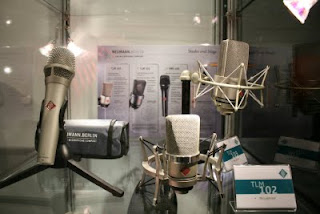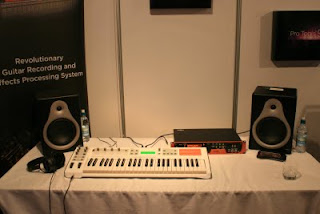
The Music Production Show took place in Leeds on May 13 and 14. The show boasted a number of essential distributors in the music production industry, along with academic institutions and a good range of seminars. It’s a first time event in Leeds, organized by UK Music Shows Ltd and sponsored by The Production Room, KMR Audio and MusicTech Magazine. The next show will be in London in November.
An updated list over exhibitors associated with the show at any give time can be found here.

Propellerheads ‘Record’ seminar.

Not really having had a chance to try out Propellerheads' critically acclaimed ‘Record’ software yet, we got an up-close look at some of its features in this seminar. The interface is familiar to anyone who has used a traditional mixing console and the wiring of the different units within the software builds on the same idea as in ‘Reason,’ also from Propellerheads.
The analogue SSL-looking interface should appeal to anyone who likes working on a traditional desk. For traditional mix down the Harrison Mixbus Console software is also a good solution, but Record is a much more complete DAW. Record seemed annoyingly good for a devoted ProTools user and I suspect I will end up owning a copy some time in the future.

(DJ and producer Stephen Lynch taking interest in the PreSonus’ Studio Live console.)
Having only seen the PreSonus Studio Live consoles in reviews and in videos I had found them a bit untidy. The signal path that is usually placed vertically or accessed through a menu is laid out horizontally across the desk. This is making one channel cross all other channels at the same time, but all my worries were in vain! It is a very simple console to get into and if it sounds anything as good as the reviews say, it is a bargain! On the wish list, a screen with better resolution would be in order and so would fully automated faders. But then the price wouldn’t be such a steal anymore and it’s original appeal partly lost. However, it would be great to see a new top of the range in the future with the functions mentioned, thunderbolt plug, 32 lines and some extra pro-functions. Especially in a time when rack mounted converters with PCI cards are starting to see competition from various expansion cards and FireWire solutions. Such an upgrade could buy the Studio Live range a place in more professional environments than at current. It would also be a great semi-professional and affordable console for the education sector. Anyway, it’s worth the dream and the current consoles are fab!
Another desirable piece of kit at the Source Distribution stand was the Universal Audio 4-710d. With four Twin-Finity preamps, digital outputs and 1176-style compression it is a versatile workhorse for people who need more lines than the average stereo pre-amp can provide. For anyone recording drums, live strings or bands through Digi 003s and Focusrite Liquid Saphires and the likes, this is one of the best next investment stages for their recording chains currently on the marked.

(Neuman KH 120 A)
With one of the strongest brand names in music production gear for close to a hundred years, German microphone manufacturer Neuman has recently moved into the monitor marked.

(New old classics.)


The Neumann Solution-D system encompasses digital microphone interfaces that uses the AES/EBU format and a range of microphones with digital outputs. Solution-D microphones can be distinguished by their blue label, as opposed to the regular red label of Neumann microphones, and they have a ‘D’ added to their model number.

Since the first news of its arrival over a year ago I have wanted to get my hands on the new FireWire mixer from Allen & Heath. The GS-R24 builds on the success of the Zed R-16, which has been praised both for its great sound and functionality. When Sound On Sound Magazine tested the R-16 a couple of years ago they suggested that the preamps might actually sound better than the old Digidesign Control 24. The Control 24’s Focusrite preamps were never known for being the best, but they were of a very respectable quality non-the less. That a little pad with a computer-cable running to a laptop could possibly do better sounding recordings at a fraction of the cost was indeed interesting news back then. But now there is a big brother! It’s got more tracks, midi-functions, two tube channels and a meter-bridge. Of you also include the optional FireWire card and fader-automation, the price is roughly around six and a half thousand Pounds in the UK. This is the same prise-bracket as the old Control 24 and the newer C24, now from AVID. But in the C24’s case you might have double the amount to include a converter system with the same track count. And then off course, you’ll need a big computer where you can fit the PCI cards. With the top-spec GS-R24 you’ll need a cable and a laptop and you’re ready to go.
I’m a big fan of AVID’s hardware and in many ways there’s nothing just like their complete systems for the professional studio. But if you’re looking for a cost-effective tracking system or enjoy working on analogue consoles and maybe even once used DA-88s and ADATs; Allen & Heath potentially just cut your new investment costs in half for a 24 channel multi-track system. And that, while maintaining a high sound quality.
The user-manual for Mackie’s once very successful 8-bus series said that no other console had ever produced so many hit-records. The Mackie was affordable and good enough. The new GS-R is affordable and better sounding. For smaller studios and colleges I believe expensive solutions based on PCI-systems are about to be substituted with new FireWire systems (and possibly RJ-45) and Thunderbolt in the future. This mixer helps to define that emerging bracket.
An exciting feature with the GS-R24 is the two valve channels that you can mix through. We loaded up a Bob Marley master-tape in a Logic session and had a play with the channels. At low drive the valve-channels sounded nice and clean, but when we pushed the drive to the max it really brought the sound out in the mix. There was no real sense of distortion (though louder sounds may react differently), but a real sense that the instrument came out of the speakers and into the room. Playing an electric guitar through the valves at high drive made our small PA speakers sound like there was an additional valve-combo hidden behind the mixer.
For further information on this mixer, Sound On Sound Magazine has just done a comprehensive test. For link, click here. For more information on the Zed R-16, click here for the 2008 test of this mixer by the same magazine.

SSL Nucleus is a great DAW controller that includes two SSL preamps. It comes bundled with SSL Duende Native plug-ins. But the most interesting feature is possibly that it can juggle between several different DAWs at the same time.
Though it would increase the cost I would love to see this machine with 8 or more preamps in the future. Just think of the possibilities if it could track a whole drum kit and had an additional 8 lines in and 8 lines out, and a FireWire connector.
Audio-Technica
Audio-Technica had a stand with a great selection of microphones and headphones. Being a brand that have made their mark with high quality at competitive prices, microphones like their AT-2020 has received a lot of positive talk in the industry press.
I was keen to test out the ATH-M50 headphones, which is the only studio-headphone they make that I had no experience with. The exhibitors had set up a MacBook Pro with an Apogee Duet interface so we could try out the headphones we wanted. I found a familiar track in their iTunes and plugged the headphones in. What struck me at first was how ‘open’ the M50s sound. Compared to the harder sounding M40s there is an extended bass range and they are less mid-heavy. Going from M40s to M50s is really a bit like switching from small near-field monitoring to big main or mid-field monitoring. The only thing I would like differently with the M50s would be a little more definition in the mid-range. A little touch of Adam’s well defined midrange monitor-sound would be a great help when working with vocals.
At loud volumes I find that the M40s have a tendency to distort quite a bit. I pushed the M50s slowly up as loud as my ears could stand. There were no tendencies to distortion and they gave me a big smile on my face! I tried to do the same with the M40s and quite swiftly found their faults.
M50s will be great tools as studio fold-back, and for editing and listening. When mixing, you might have to pay attention to the seemingly soft mid-range. This is not a big issue and the headphones are more than good. If you’re a student who’s mixing on cans by night and speakers by day to not get evicted from your house, this is a perfect tool! The listening experience, volume-tolerance and dynamics are fantastic and the applications it can be used for are diverse. I own several pairs of Audio-Techinca headphones, and I have been much fond of the M40s. –but I have never thought the time for an upgrade was as ready as now!

(M-Audio makes surprisingly good monitors nowadays, even for picky ears.)
New M-Boxes
AVID’s new M-Boxes have grown up for real! There’s only one line of preamps in the new models and they are the same as the ones in AVID’s top consoles. The M-Box Pro (3rd gen.) has hence truly become a piece of pro-equipment for serious songwriters, producers with space limitations and small production suites. Its connectivity makes it ideal for anyone with a few pieces of well-chosen kit, the new studio matrix makes it ideal for a double speaker set-up, and its pre-amps are the same as you’ll find in big studios with AVID hardware. Not to mention, the new improved casing seems to be bombproof! The M-Box pro-model just went from semi-pro to pro!

(We all fell in love with the Euphonix control surfaces once again. Music producer and creative entrepreneur Philip Edwards and Stephen Lynch at the AVID stand.)
Academic Institutions
My own college, Leeds College of Music was naturally present at the show. It was also great to get to meet representatives from Hull College. With a broad range of courses at Hull School of Performing Arts, they offer a versatile platform for educating creatives. They also offer evening courses and summer school in ‘Electronic Music Production’ and ‘Music Recording.’
Final Remarks
The Music Production Show in Leeds was clearly a big hit! Leeds is a city with a well-developed music scene. Both thanks to the community itself and Leeds College of Music, this city is literally bursting with musicians from all over the world. Still, the international music-scene output from Leeds is comparatively small besides London and the likes. With some top class suppliers of equipment in town, a music industry in global change and a local music community in growth, there could only be a question of time before an initiative like this hit Leeds. Moreover, it shows that there is a growing recognition for the potential in Leeds amongst suppliers, creative academia and other important players. With a well-educated and well-equipped musician’s community, the next big step for Leeds is to communicate to the world what it is up to.
If I wanted to start a UK-based production house with top-notch access to musicians and suppliers, but avoid the competition in London, this would be the place. It is great to see the production-industry thinking the same, and I’m looking forward to future Music Production Shows up North!

